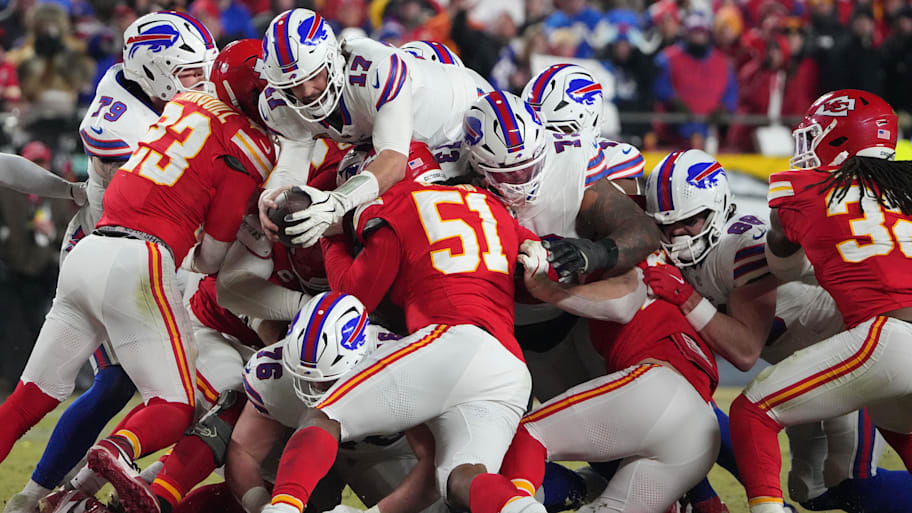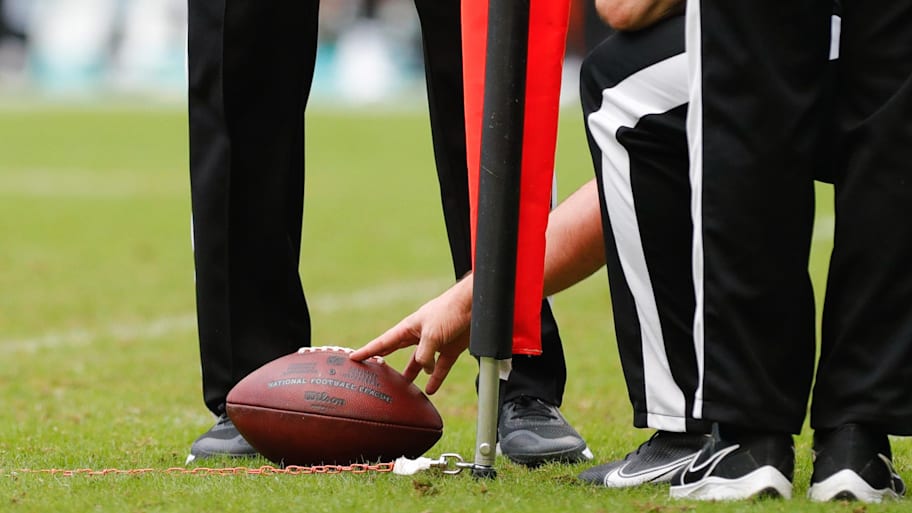The questions Brian Urlacher asked in July became common ones during the NFL preseason. Maybe even the reaction, too, because the Bears’ legendary linebacker was shocked when he first heard about the possibility of the league moving away from the chain gang to determine first downs.
“What?” a confused Urlacher first asked as his mind became foggy, standing in front of the picturesque Lake Tahoe before a round of golf at the American Century Championship in July. The Hall of Famer couldn’t fathom the idea of the chain gang no longer being utilized to measure first downs. The crew holding a 10-yard length of chain with an orange pole on each side has been around longer than a century, performing an archaic routine that has, for the most part, gotten the job done and probably been underappreciated—until now.
For the first time in the regular season, the NFL will use cameras as the primary method for measuring first downs, starting Sept. 4, when the Eagles host the Cowboys in the NFL Kickoff Game. The league partnered with Sony’s Hawk-Eye virtual measurement system with the hopes of accurately and efficiently measuring the distance between the spotted ball and the line to gain. Stadiums hosting NFL games will be equipped with six 8K cameras for optical tracking of the position of the ball. The league’s officiating center in New York will operate the system.
Now, about those common questions, which the league has had to answer for a lot more in the past month, while the officials on the field and those operating the cameras in New York have rushed to get on the same page and iron out the kinks during preseason games.
Thoughts on the NFL’s new virtual measurement system for first downs?? 🤔
— Sports Illustrated (@SInow) August 1, 2025
(via @NFL)pic.twitter.com/afaydpcfrR
“How are you going to see it during a game where the first down is?” Urlacher began to ask after gathering his thoughts. “I don’t understand that. I don’t like that. I like the chain gang. I like those guys. I used to like talking to them during the game. That stinks. The game is getting too advanced for me.”
In Urlacher’s defense, this reporter did a poor job initially of explaining that the chain gang will still be on the field for the visual aspect of letting teams know where the line to gain is located. The chain gang will also need to stay ready as the secondary method for measurement in case the high-tech cameras aren’t functioning correctly. So, yes, players and coaches can still banter with the chain gang, and they can technically still shout “move the chains!” They, along with the thousands of fans in the stadium and millions of viewers at home, will have to wait until stadium boards and TV screens flash the virtual measurement graphic, which certainly isn’t as dramatic as having the chain gang run out in a panic.
“I’m old school, I like the drama,” says Dean Blandino, Fox Sports’s NFL and college football rules analyst. “Everybody get out of the way, and we’re going to stretch the chains and see. But I get it from a technology standpoint. We can do something that’s going to streamline it.”

‘The officials still spot the ball’
NFL officiating and rules analyst Walt Anderson wants to make it clear to NFL teams and football fans: The virtual first-down measurement technology will not determine the spot of the football. Again, this technology will not determine the spotting of the football.
The six 8K cameras don’t help with spotting the ball. The virtual first-down measurement only works once the officials spot the ball on the field. This new process is about speed and accuracy for measuring the line to gain, not where to place the ball.
“The officials still spot the ball. “There’s nothing in this system that’s used electronically to spot the ball. There are no lasers. There is no device that measures the position of the chip and the ball. A lot of people think that’s the case. The official still has to spot the ball.” Walt Anderson
“The officials still spot the ball,” Anderson says. “There’s nothing in this system that’s used electronically to spot the ball. There are no lasers. There is no device that measures the position of the chip and the ball. A lot of people think that’s the case. The official still has to spot the ball. All the virtual measurement does is take a snapshot of that ball that’s on the ground that the officials have put down, and it basically triangulates, if you will, the position of that ball relative to the field and the 10 yards that the system knows that the team has to get to get a first down.
“What we want to work toward is trying to get it as efficient and as quickly up on the board as we can.”
Buccaneers quarterback Baker Mayfield understood what Anderson and his team are striving for: “It should be more accurate. It should help the pace of the play.” However, Mayfield hesitated when asked if more technology is good for the game. “We’ll see,” he says.
Trusting the cameras will take time. Paranoid coaches even questioned whether the chains had an extra link, especially those on the wrong end of a first-down measurement. In 2009, head coaches didn’t think we’d ever get to this point. Many in this video even said they saw no need to go away from the chain gang. But here we are, and the news of the fancy technology being used to measure first downs has been underwhelming to many.
Had the virtual measurement been unveiled soon after the infamous index card game of 2017 between the Raiders and Cowboys, coaches and fans may have welcomed it. Instead, it comes on the heels of the controversial AFC title game between the Chiefs and Bills, which ended with questions of whether the officials had the right spot on Josh Allen’s failed fourth-down attempt.
The virtual measurement review process hasn’t progressed as quickly as the league would like, but there’s optimism the pace will pick up over the course of the regular season. For now, the league wants players and coaches to trust in the technology to provide perfect measurements. Still, that won’t stop teams from asking about the spotting of the ball.
“That’s the question everybody wants to answer with technology, but that technology just doesn’t take into account all the factors that have to be considered relative to the rules and how the game is played,” Anderson says.
There’s still the issue of the football not being round like a tennis ball. It’s a prolate spheroid, to be exact. That’s an issue, however, that can soon be solved with technology, according to Anderson. The bigger problem is determining when and which part of the player’s body was down.
“Once we describe [the issues], everybody goes, ‘Oh, yeah, that’s right,’ because I got this question asked yesterday,” Anderson says.

Striving for speed, accuracy and presentation
While technology hasn’t yet figured out how to properly spot the football, the league should benefit in several areas from the six Hawk-Eye 8K cameras, the biggest being the accurate measurements.
“I’m here for it,” 49ers fullback Kyle Juszczyk says. “There are so many advances in technology, and if it’s accurate, then I think we should be as accurate as possible. I figured that it would happen eventually. I’m interested to see how it goes.”
While accuracy should be of utmost importance, the league is still working on the speed and presentation. Eventually, the league aims to have the virtual measurement displayed on video boards within 10 to 12 seconds. Last year, in the preseason, when the NFL first experimented with the new technology, the process took too long. The speed has improved, giving the league the runway to commit to this for the 2025 season. Still, the snag this preseason has been the presentation of the virtual measurement.
Fans in the stadium are unsure of what’s going on the field when a virtual measurement is in progress, making the 30 seconds or so of delay seem like an eternity. There’s also the presentation from the TV networks. Early in the Bears-Bills preseason game, the TV was quick to flash the virtual measurement, despite the officials on the field trying to figure out whether the play was a catch or not.
“We’re working with our network partners to be sure that it’s presented in a manner that’s not only potentially entertaining for the fans, but that something is going on whenever people are watching the TV,” Anderson says.
“It’s a learning process for us, like really anything new. We’re stopping the game more in the preseason than we would in the regular season for the very purpose of just practicing.
“I don’t think there’s going to be a lot of downside to this. As long as everyone understands this isn’t actually spotting the football.” Dean Blandino, Fox Sports
“You really want to get the speed as efficient as you can, and one of the things that we have to realize, the audience, everybody is used to watching [the chain gang], and one of the things that we noticed is the process is taking us a lot less time, but nobody is sure what they’re really looking at. It might seem longer when it’s really not, so those are some of the challenges.”
Blandino expects teams to be more aggressive on fourth down due to the accurate measurement. Coaches will know exactly whether they need a yard, a foot or an inch. As for the one downside for coaches, once the speed improves, asking for measurements as a stalling tactic might no longer be an option. But if coaches aren’t pleased with the accurate measurement, they can still challenge the play because, once again, humans are still spotting the football.
“They can still challenge the play because the measurement is just where the official put it,” Anderson says. “It’s not guaranteeing that the official put it in the right spot. Either coach can wait until the measurement is done, and then they can challenge, giving replay officials more time to look at the video.”
If the football public isn’t complaining about the virtual measurements come the regular season, that likely means this new method was a success and the league got the accuracy, speed and presentation it wanted all along. Still, the praise for it might be minimal unless the league finds a way to add the drama the chain gang provided for more than a century.
“I don’t think there’s going to be a lot of downside to this,” Blandino says. “As long as everyone understands this isn’t actually spotting the football. We won’t have any referees pulling out index cards or anything like that, which I kind of like. Maybe that’s the downside.”
This article was originally published on www.si.com as What the NFL’s New Virtual First-Down Measurement Will Actually Determine.
